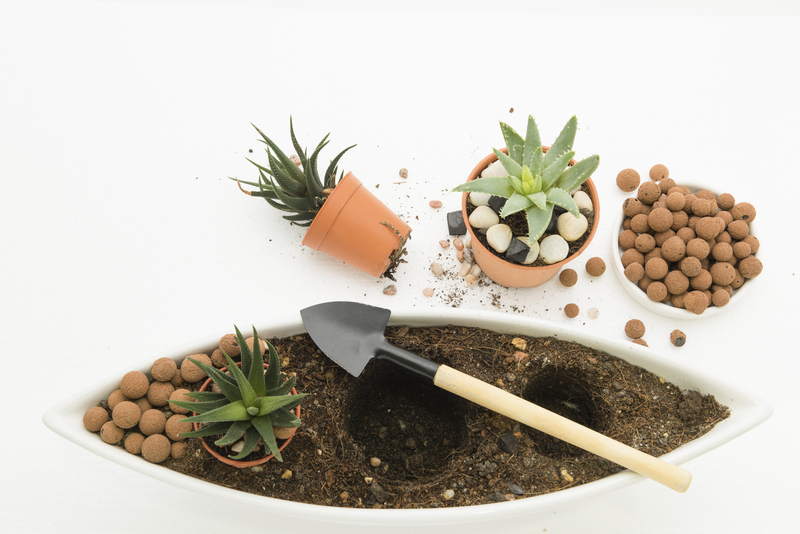From Organic Refuse to Earth's Fertile Blanket
Posted on 27/08/2025
From Organic Refuse to Earth's Fertile Blanket: The Journey of Composting
In an ever-growing world, the significance of transforming organic refuse into a fertile blanket for the earth cannot be overstated. Every day, households, restaurants, and industries generate tons of organic waste. But instead of discarding this "refuse" as rubbish, an age-old practice offers a sustainable solution: composting. This remarkable process turns kitchen scraps and yard trimmings into nutrient-rich soil, nourishing our planet's surface and enhancing plant growth. In this comprehensive guide, we'll explore the exciting journey of organic refuse--from waste to the earth's fertile embrace--and explain how anyone can participate in creating a healthier environment.

What Is Organic Refuse?
Before delving into composting, it is vital to understand what organic refuse encompasses. "Organic refuse" or "organic waste" refers to any biodegradable material stemming from living organisms. These materials can decompose naturally, unlike plastics or metals.
Common Types of Organic Refuse
- Fruit and vegetable peels
- Eggshells
- Coffee grounds and filters
- Tea bags
- Grass clippings and leaves
- Wood chips and sawdust (from untreated wood)
- Plant trimmings and flowers
- Paper towels and napkins (unbleached)
It's important to note that not all kitchen or yard "waste" is suitable for composting. Avoid adding meat, dairy, or oily foods, as these attract pests and disrupt the natural decomposition process.
The Composting Process: Turning Waste into a Fertile Blanket
Composting is a controlled, natural process where microorganisms break down organic materials into a dark, crumbly substance called humus. This organic matter serves as the earth's nutrient-dense blanket, replenishing soils and supporting healthy ecosystems. Here's how the process unfolds:
1. Collection and Sorting
Gather organic refuse from your kitchen and yard. Sorting ensures that only compostable materials go into your pile or bin, resulting in a higher quality finished product.
2. Layering for Success: Browns and Greens
Successful composting relies on balancing two major components:
- Browns: Carbon-rich materials, such as dried leaves, straw, or shredded newspaper
- Greens: Nitrogen-rich substances, like fresh grass clippings, vegetable peels, and coffee grounds
3. Moisture and Aeration: The Key to Life
Microbes require moisture to thrive. The pile should feel like a damp sponge--too dry and decomposition slows, too wet and you risk odor-causing anaerobic conditions. Turning the pile every week or two introduces oxygen, another critical element. Aeration prevents foul smells and accelerates the breakdown of organic refuse into fertile ground covering.
4. The Microbial Magic
As microorganisms digest the organic refuse, heat builds within the pile. This warmth speeds up chemical reactions, breaking down complex structures into simpler compounds. Over weeks or months, temperature fluctuates as different microbes take over, culminating in a dark, earthy-smelling material: finished compost, or Mother Nature's fertilizer.
Benefits of Transforming Organic Refuse into Earth's Fertile Blanket
The transition from organic waste to fertile compost yields extensive benefits for both the environment and humanity. Let's explore why this practice deserves widespread adoption.
Reduces Landfill Waste
A significant portion of municipal solid waste is organic. According to the Environmental Protection Agency (EPA), food scraps and yard waste make up over 30% of what we throw away. Instead of rotting in landfills--where decomposition releases harmful methane gas--composting diverts this resource, minimizing environmental impact.
Enriches Soil & Improves Plant Growth
Adding compost to gardens, farms, and landscapes creates a fertile blanket that protects and nourishes the earth's topsoil.
- Improves soil structure: Compost encourages crumbly, aerated soil that holds water efficiently.
- Supplies vital nutrients: It's a slow-release source of nitrogen, phosphorus, potassium, and micronutrients.
- Supports beneficial microbes and worms: These organisms maintain soil health and boost productivity.
Reduces Need for Chemical Fertilizers
Synthetic fertilizers, while effective, can contaminate waterways and degrade soil over time. Compost replenishes nutrients naturally and sustainably, drastically reducing the need for chemicals.
Suppresses Plant Diseases and Pests
Healthy soils with a robust layer of organic matter harbor microbial populations that work as natural disease suppressants, making plants more resilient.
Mitigates Climate Change
By converting organic refuse to earth's fertile blanket, composting significantly reduces greenhouse gas emissions. It sequesters carbon in the soil, counteracting the effects of climate change.
Methods of Composting: From Kitchen Bin to Industrial Scale
Whether in a small apartment or on a sprawling farm, there are diverse ways to transform organic refuse into nourishing compost. Here are popular composting methods:
1. Backyard Composting
- Use a simple pile or dedicated bin in your yard.
- Layer browns and greens, add moisture, and turn regularly.
- After several months, harvest rich compost for your garden.
2. Vermiculture (Worm Composting)
- Red worms digest kitchen scraps in a controlled bin.
- Produces worm castings, a premium soil amendment.
- Ideal for apartments or spaces with limited outdoor access.
3. Bokashi
- Fermentation-based method using beneficial microbes.
- Allows composting of dairy, meat, and cooked foods often avoided in other methods.
- Fast, odor-minimized, and compact.
4. Community and Municipal Composting
- Neighborhood or city programs collect organic refuse for large-scale composting.
- Finished compost is distributed to residents, parks, and farmers.
- Reduces waste citywide and builds healthy urban soils.
5. Industrial Composting
- Uses advanced equipment and high temperatures to process massive volumes rapidly.
- Accepts compostable packaging, food, and yard waste from businesses and institutions.
- Essential for building a circular economy.
How to Start Composting at Home: Step-by-Step Guide
Embracing the journey from organic waste to earth's fertile blanket is straightforward. Here's how to start in your own backyard or balcony:
1. Choose a Location
Pick a shady, level spot near a water source. Ensure your compost pile or bin is easily accessible year-round.
2. Prepare Your Pile or Bin
- If using a bin, ensure it has ventilation.
- Start with a layer of coarse material (twigs or straw) for drainage.
3. Alternate Browns and Greens
Add organic refuse as it accumulates, alternating brown and green layers. Chop or shred larger items to speed decomposition.
4. Maintain Moisture and Aeration
- Water the pile as needed; it should be damp, not soggy.
- Turn the pile every 1-2 weeks to introduce oxygen.
5. Monitor and Harvest
- In a few months, the compost will darken and smell earthy.
- Sift finished compost and apply a thick layer to your garden beds, containers, or lawns.
Common Questions: Composting Myths and Realities
Is Composting Difficult or Time-Consuming?
Absolutely not! Composting is as simple as collecting scraps, adding them to a pile, and turning it periodically. With a little regular attention, anyone can transform household waste into valuable soil amendment.
What If I Don't Have a Garden?
Even without outdoor space, apartment dwellers can compost with countertop bins, worm composting setups, or by joining local community programs.
Is Composting Smelly?
A well-managed compost bin should have a pleasant, earthy scent. Odors arise when there's too much wet, green material or insufficient aeration. Balance, moisture control, and turning will keep your compost fresh.
Can Composting Really Help the Earth?
Yes! Every bit of organic refuse diverted from landfills makes a difference. Composting supports sustainable agriculture, reduces greenhouse gases, and builds resilient soils.

From Organic Waste to Earth's Fertile Blanket: A Planet of Possibilities
As we confront challenges like soil depletion, food insecurity, and climate change, turning organic refuse into fertile ground is more vital than ever. Every banana peel or fall leaf has the potential to close the loop: feeding the earth instead of polluting it. Composting is a tradition as old as agriculture--but more crucial today than ever before.
By participating in the composting journey, each of us can nurture the planet, enrich our gardens, and create a cleaner, greener future. Whether you have a backyard, balcony, or only a kitchen countertop, the path to turning "waste" into a fertile blanket is open to all.
Key Takeaways: Composting for a Better Tomorrow
- Composting transforms organic refuse into a fertile blanket, revitalizing the earth and supporting sustainable growth.
- Adopting composting at home or in the community saves resources and mitigates greenhouse gas emissions.
- Rich, living soil isn't just good for plants--it's essential for food security, climate mitigation, and environmental restoration.
Start your composting journey today, and become part of the global shift from wastefulness to abundance, from organic refuse to the fertile blanket that wraps and rejuvenates our precious earth.

